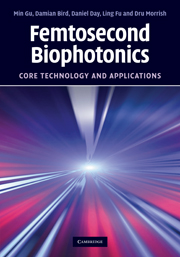Book contents
- Frontmatter
- Contents
- Preface
- 1 Introduction
- 2 Nonlinear optical microscopy
- 3 Two-photon fluorescence microscopy through turbid media
- 4 Fibre-optical nonlinear microscopy
- 5 Nonlinear optical endoscopy
- 6 Trapped-particle near-field scanning optical microscopy
- 7 Femtosecond pulse laser trapping and tweezers
- 8 Near-field optical trapping and tweezers
- 9 Femtosecond cell engineering
- Index
7 - Femtosecond pulse laser trapping and tweezers
Published online by Cambridge University Press: 07 May 2010
- Frontmatter
- Contents
- Preface
- 1 Introduction
- 2 Nonlinear optical microscopy
- 3 Two-photon fluorescence microscopy through turbid media
- 4 Fibre-optical nonlinear microscopy
- 5 Nonlinear optical endoscopy
- 6 Trapped-particle near-field scanning optical microscopy
- 7 Femtosecond pulse laser trapping and tweezers
- 8 Near-field optical trapping and tweezers
- 9 Femtosecond cell engineering
- Index
Summary
In this chapter, we introduce a new trapping and excitation technique, which utilises a single femtosecond pulse infrared illumination source to simultaneously trap and excite a microsphere probe. The induction of morphology dependent resonance (MDR) in the trapped probe is achieved under two-photon excitation. Monitoring of the MDR in the trapped probe provides a contrast mechanism for imaging and sensing. The experimental measurement of MDR within a laser trapped microsphere excited under two-photon absorption is confirmed in Section 7.2. The effect of the laser power as well as the pulse width on the transverse trapping force is investigated in Section 7.3. The dependence of two-photon induced MDR on the scanning velocity of a trapped particle is then experimentally determined. These parameters are fundamental to the acquisition of images and sensing with femtosecond laser tweezers as described in Section 7.4.
Introduction
Laser trapping is an ideal method for the remote, non-invasive manipulation of a morphology dependent resonance microcavity. Controlled scanning and manipulation of the microcavity is possible via laser trapping. The microcavity has an enhanced evanescent field at its surface due to the resonant circumferential propagation of radiation at glancing angles greater than the critical angle. Freely suspended in a medium, the cavity becomes increasingly sensitive to its surrounding environment. The interaction of the cavity with its local environment during scanning dynamically alters the coupling to and leakage from the cavity. Monitoring the change in coupling to and leakage from the cavity over time enables imaging and sensing.
- Type
- Chapter
- Information
- Femtosecond BiophotonicsCore Technology and Applications, pp. 149 - 169Publisher: Cambridge University PressPrint publication year: 2010



